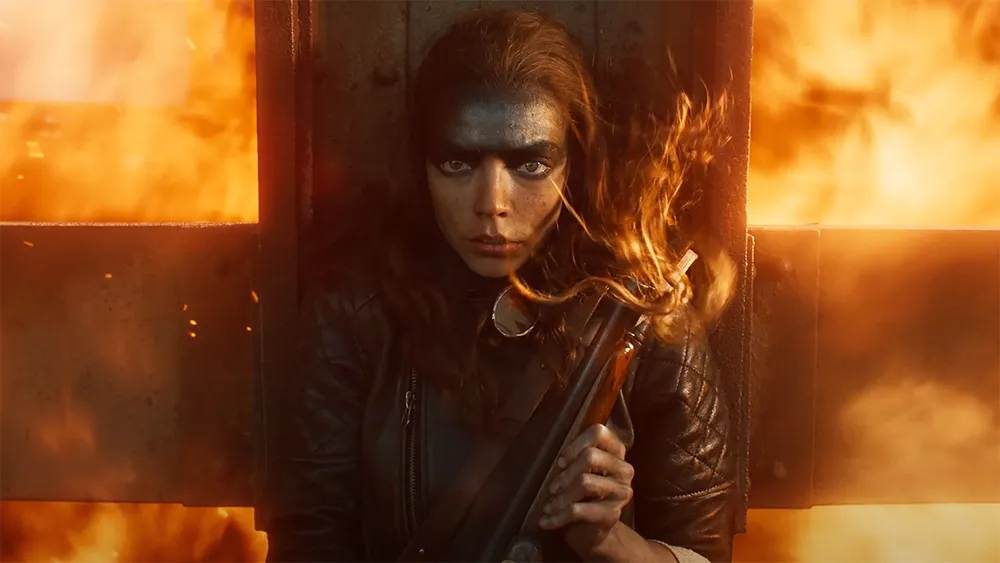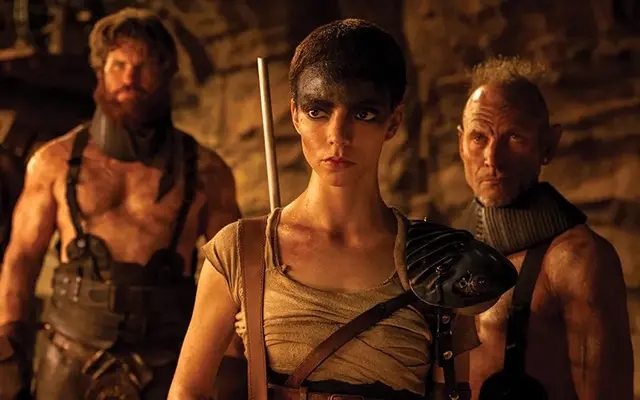“Do you have what it takes to make it epic?” Dementus (Chris Hemsworth) asks this question of Furiosa (Anya Taylor-Joy) toward the end of Furiosa: A Mad Max Saga. But it might just as well be a challenge offered to director George Miller. To say that Miller’s 2015 action movie Mad Max: Fury Road came out of nowhere doesn’t feel quite accurate; after all, it’s the fourth installment in a popular and largely well-regarded series the Australian filmmaker began all the back in 1979. But, coming 30 years after the franchise’s previous entry (1985’s Mad Max Beyond Thunderdome) and following a decidedly lengthy and fraught production, I can’t say that hopes were high. I know it wasn’t on my radar prior to its release, even though I was a good six years into regularly reviewing current movie releases. But the incredible craft, the thrills, the memorable characters (familiar and new), and the lean yet rich storytelling present in Fury Road blew critics and audiences away. In Kyle Buchanan’s book Blood, Sweat, & Chrome: The Wild and True Story of Mad Max: Fury Road, critics and journalists who were among the first to screen the film recount not quite being able to believe what they were seeing; Allison Willmore says, “You know how sometimes when you see something, you feel a little drunk on it? This was one of those experiences, and for those of us who watch as many movies as we do, that was rare and treasured.” Meanwhile, Justin Chang states that “It’s incredibly propulsive filmmaking that pulls you into this world immediately. I don’t think I breathed for two hours.” Fury Road’s unprecedented run culminated in nine Academy Award nominations (including for Best Picture), of which it won six.
So how do you even begin to top that? You can’t recapture lighting in a bottle, but Furiosa (an origin story for the Imperator Furiosa character originated by Charlize Theron, which Miller originally intended to shoot back-to-back with Fury Road before its hellish production battles got in the way) comes pretty darn close. Miller’s (who cowrote the screenplay with previous collaborator Nico Lathouris) skill at myth-making and playing with the bones of existing stories and legends comes into play immediately, when young Furiosa (played by a truly great Alyla Browne), a stand-in for Eve, plucks her apple (a peach) from a tree in her Eden (her home, a rare green haven in post-apocalyptic, largely sandy and dry Australia, is later referred to as a “land of abundance”), and is shortly thereafter ejected from paradise, captured by raiders working for the Warlord Dementus (Chris Hemsworth). Thanks to her quick-thinking, Furiosa is able to alert her family to her distress, and her mother Mary (Charlee Fraser) is in hot pursuit. Ultimately, Dementus does not only kill Mary; he recaptures Furiosa, whose devotion to her mother prevents her escape, and claims her as his own daughter. These events unfold within the opening act of Furiosa, which trades in Fury Road’s straightforward narrative for a work that’s looser and more episodic in nature (the film is divided into five acts). To lightly sketch some of the film’s occurrences, which take place over a span of many years, Furiosa eventually ends up at the Citadel (the settlement led by Immortan Joe, Hugh Keays-Byrne being replaced in this film by Lachy Hulme, where we find Furiosa at the start of Fury Road), first as a potential bride, later as a worker disguised as a boy, ultimately learning how to command a War Rig (a heavily-armed tanker that makes supply runs across the Wasteland) from Praetorian Jack (Tom Burke).

There a few threads running throughout Furiosa— as Furiosa struggles to survive, she works her way up the ranks at the Citadel, while also seeking vengeance against Dementus, and also attempting to return home, or at the very least plant the seed her mother gave her and create another Green Place— but it’s a credit to the film’s even pacing that it never becomes overly bogged down in exposition. If anything, I could have used a little more (the film jumps over the entirety of her training with Jack, for example), and a lot of what we see on screen, at least in the earlier stages of the film, don’t directly center on its subject; Furiosa, while she is present on screen, isn’t a core participant in trade discussions between Dementus and Immortan Joe, for example. And yet, the film is so compelling, so incomparable to anything else in its league (except, of course, Fury Road), that those quibbles barely register. It’s a little bit due to Hemsworth’s performance, which is certainly the best in his career so far; the actor is only truly great when he is playing kooks, and Dementus, with his motorcycle-drawn chariot, pompous and sadistic demeanor, and prosthetic nose that renders the heartthrob virtually unrecognizable, certainly fits that bill, but Hemsworth also imbues him with a streak of melancholy (there are allusions to a family killed in the catastrophe, a teddy bear belonging to his loves perpetually strapped to his person, and his desire to pigeon-hole Furiosa into serving as a sort of replacement child) that turns his character from a villain into a tragic character. It’s a little bit due to the world-building, the details in which make Furiosa a wonder to behold, with much of the Oscar-winning team from Fury Road returning: costume designer Jenny Beavan, composer Tom Holkenborg, production designer Colin Gibson (just witnessing how existing parts from various vehicles are put to different uses is one of the series’ great joys), and Miller’s wife, editor Margaret Sixel. It’s a little bit due to the side characters, who even with limited screen time are intriguing enough to make the viewer wonder, “What’s up with that guy?” For me, with Fury Road, it was The Doof Warrior, a guitarist strapped to the front of a convoy; here, it’s the History Man (George Shevstov), a record keeper who serves under Dementus, endless facts and figures written on his clothing and tattooed across his skin. And it’s a little bit due to the action sequences which, like Fury Road, remain unparalleled. The physicality of bodies isn’t really the name of the game here (although those bodies are often affected; we do learn how Furiosa loses her arm here, and how that has greater significance beyond the loss of a limb); it’s how those bodies use the tech at their disposal— guns, yes, but mainly vehicles, from motorcycles to cars to enormous trucks and tankers— to dispense said action that’s truly impressive. Every chase— of which there are several in Furiosa— is riveting, and each sequence is skillfully cut between wide shots of the larger set pieces and close-ups on the humans involved, with all the requisite crashes and explosions in between. Cinematographer Simon Duggan is a newcomer to the series, but he continues the look established by John Seale (who came out of retirement to work on Fury Road) which is saturated and warm, proving that not all desert movies have to appear beige and boring (coughDunecough).

Taylor-Joy is an apt stand-in for a younger Theron, full of rage that occasionally verges on feral although she isn’t able to quite able to pull from the same place of sorrow; when, at one point, she demands her stolen childhood be restored to her, it doesn’t feel like the moment we’ve been building to all along, although that is likely more a script folly than a performance one (feminine rage is bubbling beneath the surface here, whereas it is much more the subject of Fury Road). But Burke, another newcomer with a pivotal role, fits right in; that there’s a romance between him and Furiosa is evident, but their relationship as seen on screen isn’t based on sex, but rather a shared ideology, a mutual desire for freedom from the life they’ve been living. Furiosa concludes with clips from Fury Road played over the end credits, which frankly does the film no favors. But even as it invites comparisons to its masterpiece of a predecessor, Furiosa stakes its claim as its own impeccable work of art: its masterful action sequences, thoughtful plotting and world-building, and memorable characters brought to life by incredible performers make it not only one of the best movies of the year, but one of the greatest prequels ever made.
Furiosa: A Mad Max Saga is now playing in theaters. Runtime: 148 minutes. Rated R.